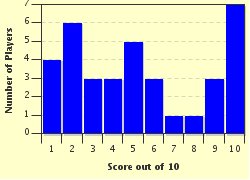Quiz Answer Key and Fun Facts
1. The first three-way tie at The Masters came in 1966 when Jack Nicklaus prevailed over Tommy Jacobs and Gay Brewer. Nicklaus had also won The Masters the previous year when he posted a phenomenal 271 (-17). What score did Nicklaus, Jacobs, and Brewer all post in 1966?
2. The second three-way tie at The Masters came in 1979 with Ed Sneed and Tom Watson as finalists. Which player participating in his first Masters at the age of 27 won the playoff on the second sudden-death hole?
3. At the 1987 Masters Seve Ballesteros and Greg Norman were tied with the eventual winner Larry Mize after 72 holes. Which incredible shot did Mize hit on the second playoff hole that helped him seal the win?
4. �ngel Cabrera won the 2009 Masters after being in a three-way tie. Which two Americans did he outlast, one an alumnus of UNLV and the other a deacon at a church in Franklin, Kentucky?
5. The 1989 Open Championship ended in a three-way tie. Mark Calcavecchia triumphed in a four-hole playoff over two Australians. One of them was Wayne Grady. Who was the other Australian, a player that previously won the Open Championship in 1986?
6. The 1999 Open Championship proved to be an extremely challenging affair. Justin Leonard and Jean van de Velde finished in a three-way tie with the eventual winner. What golfer from Scotland won the tournament despite being down by 10 shots going into the final round?
7. The U.S. Open has also seen its share of three-way ties after four rounds of golf. Which player won the tournament in 1950, the second of his four U.S. Open wins, after outlasting Lloyd Mangrum and George Fazio?
8. At the 1963 U.S. Open Julius Boros and Arnold Palmer were fortunate to end in a three-way tie with this player. Who held the lead by two strokes before a double bogey on the penultimate hole dropped him back into a tie with Boros and Palmer?
9. The 1994 U.S. Open may be one of the longest golf majors in history by number of holes played. Ernie Els, Colin Montgomerie, and Loren Roberts were in a three-way tie after four rounds. How many playoff holes were played in total before Ernie Els was declared the winner?
10. In 1978 the first three-way tie after four rounds occurred at the PGA Championship with John Mahaffey winning. Vijay Singh prevailed in the second three-way tie at the PGA in 2004. Which of the following is one of the similarities between the 1978 and 2004 PGA Championship?
Source: Author
Triviaballer
This quiz was reviewed by FunTrivia editor
gtho4 before going online.
Any errors found in FunTrivia content are routinely corrected through our feedback system.

